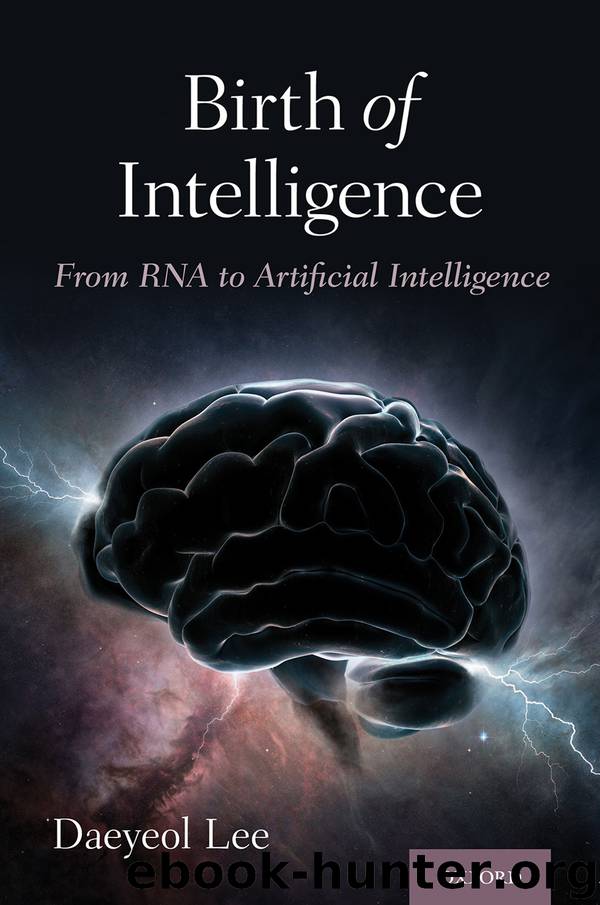Birth of Intelligence by Daeyeol Lee

Author:Daeyeol Lee
Language: eng
Format: epub
Publisher: Oxford University Press
Published: 2020-03-19T16:00:00+00:00
6
Why Learning?
Humans can learn. We can change our behavior through experience. But can animals with much simpler nervous systems learn, such as C. elegans, which has only about 300 neurons? Indeed, even animals with such simple nervous system can learn and modify their behavior through experience. For example, if C. elegans bumps its head unexpectedly into a hard object while moving forward, it immediately reverses the direction of its movement. This is called head withdrawal reflex, and it protects the animal from a potentially harmful object in its path. However, if the animal experiences the same mechanical stimulus repeatedly, it will gradually reduce the magnitude of this reflex. This is a simple form of learning called habituation. It is easy to understand why such habituation would be beneficial to C. elegans. If the object C. elegans first bumped into were indeed a predator, it is unlikely that C. elegans would be bumping its head into the same object again and again without getting eaten. If the same stimulus were repeated multiple times, it would be reasonable to assume that it is safe, since a real predator would have eaten the animal sooner. It would not be efficient for C. elegans to keep moving backwards when it is running into a completely harmless object, especially when it is hungry and needs to aggressively explore its surroundings for food to avoid starvation. Without the ability to habituate, animals like C. elegans might repeat the same withdrawal reflex unnecessarily.
Almost all animals have nervous systems, and all animals with nervous systems can learn. This is not surprising, given that nervous systems evolved to do something genes cannot do, which is to make decisions in real time while the animal’s environment changes unpredictably. Even if animals do not have the ability to learn, their nervous systems might still allow them to make appropriate decisions according to their environment, but this would be very inefficient. Without learning, animals can still produce appropriate behavior through mutations in genes that control the development of their nervous systems. If the animal’s environment changes unpredictably, many mutations over multiple generations must accumulate to modify the developmental programs so that neurons can be rewired to generate appropriate behaviors in the new environment. During such a trial-and-error process, many animals with inappropriate behavior would die from starvation or predation. By contrast, learning allows animals to modify their behavior more quickly within the lifespan of an individual. Learning makes the division of labor between genes and brains much more efficient.
A human brain has 300 million times more neurons than C. elegans. This gives humans a much greater ability to learn, and human learning is much more complex and diverse than learning in C. elegans. Almost all voluntary human behaviors are selected and refined by learning. The sophisticated finger movements of a guitarist that create beautiful music or a surgeon’s skillful movements that save many patients’ lives are both products of learning. It would not be possible to discuss human intelligence without understanding how humans learn.
Download
This site does not store any files on its server. We only index and link to content provided by other sites. Please contact the content providers to delete copyright contents if any and email us, we'll remove relevant links or contents immediately.
When Breath Becomes Air by Paul Kalanithi(7263)
Why We Sleep: Unlocking the Power of Sleep and Dreams by Matthew Walker(5641)
Paper Towns by Green John(4169)
The Immortal Life of Henrietta Lacks by Rebecca Skloot(3826)
The Sports Rules Book by Human Kinetics(3588)
Dynamic Alignment Through Imagery by Eric Franklin(3488)
ACSM's Complete Guide to Fitness & Health by ACSM(3467)
Kaplan MCAT Organic Chemistry Review: Created for MCAT 2015 (Kaplan Test Prep) by Kaplan(3422)
Introduction to Kinesiology by Shirl J. Hoffman(3299)
Livewired by David Eagleman(3121)
The River of Consciousness by Oliver Sacks(2992)
Alchemy and Alchemists by C. J. S. Thompson(2911)
The Death of the Heart by Elizabeth Bowen(2901)
Descartes' Error by Antonio Damasio(2731)
Bad Pharma by Ben Goldacre(2729)
Kaplan MCAT Behavioral Sciences Review: Created for MCAT 2015 (Kaplan Test Prep) by Kaplan(2491)
The Gene: An Intimate History by Siddhartha Mukherjee(2491)
The Fate of Rome: Climate, Disease, and the End of an Empire (The Princeton History of the Ancient World) by Kyle Harper(2436)
The Emperor of All Maladies: A Biography of Cancer by Siddhartha Mukherjee(2430)
